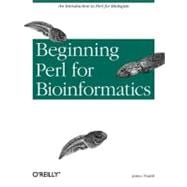
Note: Supplemental materials are not guaranteed with Rental or Used book purchases.
Purchase Benefits
What is included with this book?
James Tisdall has worked as a musician, a programmer at Bell Labs (where he programmed for speech research and discovered a formal language for musical rhythm), and as a bioinformaticist at Mercator Genetics in Menlo Park, California, and at Fox Chase Cancer Center in Philadelphia. He has a B.A. in mathematics from the City College of New York and an M.S. in computer science from Columbia University; he is working towards a Ph.D. in computer science at the University of Pennsylvania. In his spare time, Jim teaches computer music at the Settlement Music School in Philadelphia. He is also the author of O'Reilly's Beginning Perl for Bioinformatics.
| Preface | vii | ||||
|
1 | (5) | |||
|
2 | (1) | |||
|
3 | (1) | |||
|
4 | (1) | |||
|
5 | (1) | |||
|
6 | (12) | |||
|
6 | (2) | |||
|
8 | (2) | |||
|
10 | (3) | |||
|
13 | (2) | |||
|
15 | (1) | |||
|
16 | (2) | |||
|
18 | (11) | |||
|
18 | (1) | |||
|
19 | (2) | |||
|
21 | (1) | |||
|
22 | (1) | |||
|
23 | (6) | |||
|
29 | (27) | |||
|
29 | (3) | |||
|
32 | (4) | |||
|
36 | (4) | |||
|
40 | (2) | |||
|
42 | (1) | |||
|
43 | (3) | |||
|
46 | (1) | |||
|
47 | (3) | |||
|
50 | (4) | |||
|
54 | (1) | |||
|
55 | (1) | |||
|
56 | (31) | |||
|
56 | (6) | |||
|
62 | (1) | |||
|
63 | (7) | |||
|
70 | (1) | |||
|
71 | (6) | |||
|
77 | (4) | |||
|
81 | (4) | |||
|
85 | (2) | |||
|
87 | (31) | |||
|
87 | (3) | |||
|
90 | (6) | |||
|
96 | (2) | |||
|
98 | (4) | |||
|
102 | (2) | |||
|
104 | (12) | |||
|
116 | (2) | |||
|
118 | (31) | |||
|
119 | (1) | |||
|
120 | (6) | |||
|
126 | (10) | |||
|
136 | (5) | |||
|
141 | (6) | |||
|
147 | (2) | |||
|
149 | (33) | |||
|
149 | (1) | |||
|
150 | (5) | |||
|
155 | (8) | |||
|
163 | (3) | |||
|
166 | (9) | |||
|
175 | (5) | |||
|
180 | (2) | |||
|
182 | (17) | |||
|
182 | (2) | |||
|
184 | (13) | |||
|
197 | (1) | |||
|
198 | (1) | |||
|
199 | (39) | |||
|
200 | (3) | |||
|
203 | (2) | |||
|
205 | (7) | |||
|
212 | (20) | |||
|
232 | (4) | |||
|
236 | (2) | |||
|
238 | (36) | |||
|
240 | (8) | |||
|
248 | (9) | |||
|
257 | (10) | |||
|
267 | (5) | |||
|
272 | (2) | |||
|
274 | (28) | |||
|
275 | (1) | |||
|
276 | (1) | |||
|
277 | (3) | |||
|
280 | (10) | |||
|
290 | (4) | |||
|
294 | (7) | |||
|
301 | (1) | |||
|
302 | (5) | |||
|
302 | (1) | |||
|
302 | (1) | |||
|
303 | (1) | |||
|
303 | (1) | |||
|
303 | (1) | |||
|
304 | (1) | |||
|
304 | (1) | |||
|
305 | (1) | |||
|
305 | (1) | |||
|
305 | (1) | |||
|
306 | (1) | |||
| Resources | 307 | (8) | |||
| Perl Summary | 315 | (32) | |||
| Index | 347 |
The New copy of this book will include any supplemental materials advertised. Please check the title of the book to determine if it should include any access cards, study guides, lab manuals, CDs, etc.
The Used, Rental and eBook copies of this book are not guaranteed to include any supplemental materials. Typically, only the book itself is included. This is true even if the title states it includes any access cards, study guides, lab manuals, CDs, etc.